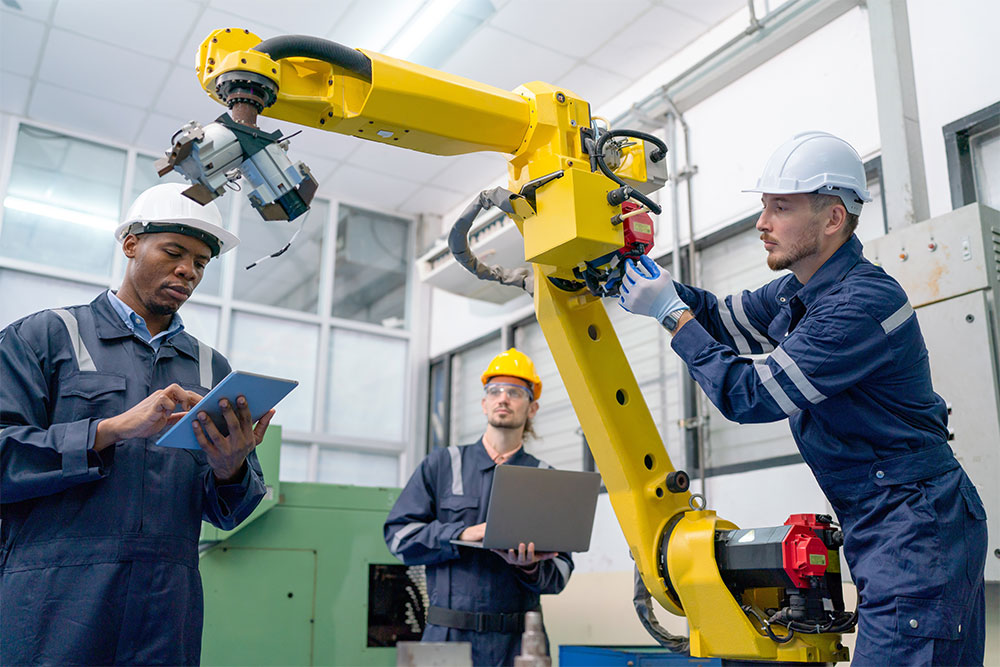
Understanding how to comply with PUWER can seem daunting. The Provision and Use of Work Equipment Regulations cover virtually every type of work and work equipment. They outline what you must do to make each tool, appliance, apparatus, machine and installation used in your workplace safe.
And work equipment risks are unique, so your safety measures must be, too. The Health and Safety Executive (HSE) also maintains a high conviction rate for PUWER failings. If a case reaches court, prosecution is almost inevitable.
But PUWER doesn’t need to be intimidating. Our guide explains how to comply with PUWER and manage equipment safety in your workplace. It sets out your duties and steps you must take to protect your employees from harm.
PUWER Legislation
PUWER stands for the Provision and Use of Work Equipment Regulations 1998. These regulations detail what must be done to make work equipment safe.
Who is Accountable
All employers who provide work equipment must comply with PUWER.
The regulations also apply to anyone who owns or controls work equipment, including:
- The self-employed
- Contractors who use their own equipment for paid work
- Supervisors or managers who oversee the safe use of work equipment
- Workers who have any control over the operation of equipment
- Companies that hire out equipment and are responsible for its condition
What Equipment PUWER Covers
PUWER covers every type of equipment used at work.
The HSE’s PUWER Approved Code of Practice (ACOP) describes the regulations as relevant to all work equipment. This definition means PUWER work equipment includes:
- New equipment
- Second-hand equipment
- Leased equipment
- Equipment not used exclusively for work.
Even work equipment with its own legislation must still comply with PUWER. For example, lifting equipment is subject to both LOLER and PUWER.
Although compliance with equipment-specific regulations is usually enough to meet more general PUWER requirements, you should always check. PUWER cannot be superseded by other legislation.
Where PUWER Applies
PUWER is relevant in any workplace that comes under the Health and Safety at Work etc. Act 1974.
This specification makes PUWER applicable to all workplaces.
How to Comply with PUWER and Ensure Equipment Safety
The overall aim of PUWER is to make work equipment safe for use. Several steps are involved in achieving and maintaining equipment safety. These steps relate to the equipment itself and its operation.
The PUWER main requirements are to:
- Ensure equipment is suitable for the intended task
- Risk assess all equipment hazards and ensure they are suitably controlled
- Inspect equipment regularly to detect faults or wear that risk users’ safety
- Maintain equipment in safe working order
- Provide adequate information, instruction and training to all equipment users and supervisors
This is not an exhaustive list. PUWER applies to all work equipment and work environments, so you may need to do more if your equipment is complex or high-risk.
Duty holders in relatively low-risk workplaces can read more about these requirements and how to comply with PUWER below.
Equipment Suitability
The Supply of Machinery (Safety) Regulations 2008 (SMSR) dictate all machinery be designed and built safely. It must also come with clear instructions on its operation and assembly if needed.
If machinery meets these safety standards, it will have a Declaration of Conformity.
You can trust that new machinery is safe if it has this Declaration and you use it the way the maker says to.
However, once you own the machinery, you must keep it safe and in good condition under PUWER. Compliance is easier if you follow the manufacturer’s instructions.
For older equipment, equipment from other countries or modified equipment, you must assess it to ensure it’s suitable and determine how to use it safely.
PUWER Assessments
PUWER work risk assessments follow the same format as general risk assessments. You look at the work equipment, its environment and what can go wrong. Then decide on controls to eliminate or reduce risks to a safe level.
Your assessment is essential for PUWER compliance. It will inform every subsequent decision on equipment safety, including when inspections and maintenance are necessary.
Because assessments are so critical, they can only be carried out by a competent person. Assessors must understand the procedure and legal framework to meet the definition of competence.
Knowledge of the equipment is also critical. While a PUWER assessment template can be helpful to get started, you can’t just follow it mindlessly.
You need to understand how every team (operators, maintenance and support staff) interacts with equipment to fully grasp the risks. So, involve these workers. They can help highlight less obvious hazards and suggest practical control measures.
Involving workers in the assessment process also increases engagement. Engaged workers will be more likely to follow approved operating procedures and avoid workarounds that risk compliance.
Apply Risk Controls
After assessing equipment, you must apply control measures.
Some control measures are considered more effective than others. This concept is shown by the hierarchy of controls, which ranks measures from most to least effective. The hierarchy is:
- Elimination – Complete removal of the hazard
- Substitution – Replace the hazard with a safer alternative
- Engineering controls – Isolate people from the hazard
- Administrative controls – Change how people work
- Personal protective equipment (PPE) – Protect workers with equipment
Eliminating the risk is always the safest option. Next is substitution.
But for some equipment risks, this is impossible. Removing the hazard or substituting equipment could make it unsuitable for the intended task, which violates PUWER.
Instead, work equipment safety is ensured by using other control measures. These measures include:
- Establishing safeguards
- Inspecting equipment to confirm it’s suitable and safe to be used
- Maintaining equipment in good working order
- Providing staff with information, instruction and training
Below, you’ll find an overview of each of these controls and what you must consider when implementing them.
Guards and Safety Measures
Guards and safety measures need to match the equipment’s risk level.
Generally, the more complex the equipment, the greater the risk. The connection between complexity and risk is why competent PUWER assessments are vital. Only experienced assessors can identify equipment-specific hazards and recommend effective guards.
Installing guards also requires PUWER knowledge. The same teams that conduct the PUWER assessment rarely follow up with the recommendations. This disconnect can cause issues. Support staff who don’t understand the why behind guards may not implement them effectively. Providing all teams with an understanding of how to comply with PUWER can help overcome this issue.
PUWER Inspections
Thorough inspections are also critical for PUWER compliance. These examinations, known as PUWER inspections, determine if equipment is safe to operate.
Only high-risk equipment needs a full PUWER inspection. Other low-risk equipment can usually be deemed safe with a quick pre-use check or visual inspection. You can decide what equipment requires a PUWER inspection using its risk assessment.

What PUWER Inspections Cover
Like assessments, PUWER inspections must be conducted by competent people. Competence is necessary because inspections are not fixed.
To develop inspection procedures, you should consider:
- The equipment’s risk assessment
- The manufacturer’s guidance
- Other relevant health and safety advice
Inspections should focus on the parts of equipment or machinery that can actually hurt someone. Checklists can help with this. They also make recording inspection findings easier (another PUWER requirement).
The HSE acknowledges that checklists are useful but cautions against overreliance. After all, inspectors must check equipment to ensure it’s safe, not to tick boxes.
When Equipment Should be Inspected
Conducting a risk assessment will also help you create a schedule for inspections. Equipment that wears out more quickly will require inspections more often.
However, inspection schedules are flexible. If equipment regularly passes its checks, you might be able to extend the time between inspections. Equally, if equipment deteriorates quickly, you’ll need to inspect it more frequently.
Equipment Maintenance
Regular inspections will flag when equipment needs maintenance to run efficiently and safely.
However, maintenance itself can be dangerous. Many workers have been injured while undertaking maintenance tasks.
You should refer to the manufacturer’s guidance before establishing your maintenance routines. It will outline safe maintenance procedures if the equipment complies with SMSR.
For equipment outside of SMSR, you must develop these procedures. Again, return to your risk assessment. It should cover risks pertaining to maintenance as well as operation.

Providing Information, Instruction and Training
Under PUWER, you must provide adequate information, instruction and training on the safe use of work equipment.
You should use your risk assessments to develop safe systems of work. And these safe systems of work should be as simple as possible to follow and, ideally, concise enough to fit on one page. These one-page documents can then be attached to equipment so any worker can check them anytime.
Training must also be provided. You’ll often be able to manage this in-house, with more experienced staff guiding others.
More extensive training may be required for high-risk equipment.
All training providers must be competent. You can typically judge this for in-house training but it can be more difficult for external providers. There’s no HSE approval scheme for work equipment training but third-party accreditation is a strong indicator of a quality training provider.
Learning How to Comply with PUWER
Identifying knowledge gaps in your business is vital for PUWER compliance.
Ensuring the safety of equipment is a collective effort that requires the understanding and involvement of everyone—supervisors, support staff and operators. They all need to be aware of PUWER and their specific responsibilities under these regulations.
Duty holders in particular need to understand PUWER. PUWER assessments and inspections take practical knowledge of work equipment combined with awareness of the surrounding regulations.
Our online PUWER Compliance Management course is designed with this in mind. It develops the depth of knowledge needed to manage PUWER duties across operations. You’ll gain a detailed understanding of the regulations, helping you ensure risk assessments and inspections meet expected standards.
The course also includes free e-Checklists for both PUWER assessments and inspections. These digital checklists can help ensure procedures are thorough and recorded for compliance.




























































































































































































































































































































































































































































































































































































































































































































































